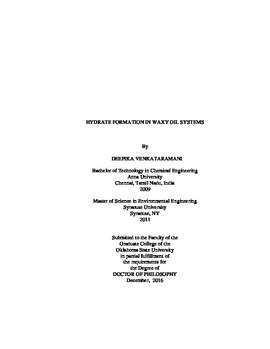| dc.description.abstract | Emulsions are of great importance due to their widespread occurrence in industries such as pharmaceutical, cosmetics, food, agricultural, and energy. In the energy industry, emulsions may be encountered in all stages of production, transportation, and extraction. Along with naturally occurring surfactants, solid particles such as asphaltenes, wax, clay, and silica are also present in crude oil. The formation and deposition of precipitated solids such as waxes, hydrates, and asphaltenes cause significant flow assurance problems for the energy industry. The motivation of this thesis was to develop a fundamental understanding of the hydrate formation mechanisms in waxy oil systems. This thesis focuses on the characterization of emulsions and hydrate formation in waxy oil systems in the presence of stabilizing agents such as a surfactant (span 80). A direct visualization and in-situ experimental method was developed for characterizing hydrate formation in waxy oil systems. Single water drop hydrate formation experiments were conducted with and without surfactant to evaluate the effect of wax concentration (1.25 and 5 wt.%), and cooling rates (0.5, 1, and 2 C/min) on hydrate formation. In surfactant free systems, the presence of wax in the oil phase was observed to enhance the diffusion resistance of cyclopentane transport to the bulk water phase and hence delay hydrate growth rate. Conversely, the presence of surfactant was observed to reduce the diffusion resistance and promote hydrate formation. Faster hydrate growth was observed in surfactant laden systems due to reduced interfacial tension, thereby enhancing the mass transfer of cyclopentane to the water phase. In the absence of surfactant, wax concentration and the cooling rates had a significant impact on the hydrate conversion time. However, such observations were not seen in the presence of a surfactant. A four step hydrate formation mechanism (wax precipitation, hydrate nucleation, lateral growth, and radial growth) in waxy oil systems was proposed based on the experimental data. Wax precipitation and hydrate nucleation were observed to be heat transfer limited processes. Lateral growth was governed by diffusion of cyclopentane to the oil/water interface, while radial growth was goverened by mass transfer of cyclopentane into the water drop. Interfacial tension was observed to play a major role in hydrate conversion rate. An in-situ experimental method was developed by direct visualization of hydrate growth in emulsions. Hydrate formation was observed to affect the emulsion morphology. Irreversible formation of multiple emulsions was observed upon hydrate dissociation. | |
